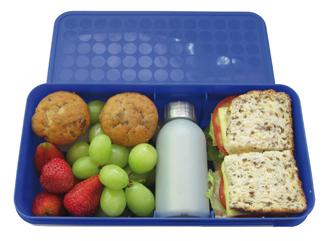 To help prevent what the USDA calls a serious public health threat…foodborne illness in the lunchbox; follow these six top tips for keeping foods safe.
To help prevent what the USDA calls a serious public health threat…foodborne illness in the lunchbox; follow these six top tips for keeping foods safe.
- If you’re packing meats, eggs, yogurt or other perishable food, use at least two freezer packs. Harmful bacteria grow rapidly between 40 and 140 degrees Fahrenheit.
- Juice boxes can provide another option: freeze some juice boxes overnight to use with at least one freezer pack. The frozen juice boxes will thaw by lunchtime.
- If there’s a refrigerator at school or work, find a space for your lunch. Remove the lid or open the bag so the cold air can circulate better.
- Use an insulated, soft-sided lunchbox or bag instead of a paper bag. Perishable food can spoil more quickly in a paper bag.
- For a hot lunch like soup, use an insulated container. Make sure the container remains tightly closed until lunchtime.
- And finally, throw out all leftover food, used packaging and paper bags.
Medline Plus, a service of the National Institutes of Health, reminds us that not all illness comes from the food. It can come from a lunchbox that is not properly cleaned, or from the area where the lunch was prepared. They ask that we please remember that:
- A dirty lunchbox may contain bacteria that can make a youngster sick.
- A lunchbox picks up a lot of grime in a day.
- Kids don’t always wash their hands before handling their lunchboxes and food.
- It’s a good idea to put a small bottle of antibacterial gel with a tight-fitting lid in your child’s lunchbox. Your child can use the gel when there isn’t a chance to wash with soap and water before eating lunch.
- Kids should avoid setting down their food on the table. Include a paper towel, a piece of wax paper, or even a small fabric place mat in your child’s lunchbox that can be washed at home to help keep food off surfaces that may have been used by a number of youth and adults.
When packing a lunchbox:
- Start with clean hands, a clean work surface and a clean lunchbox.
- Disinfect kitchen surfaces, such as kitchen equipment and refrigerator handles, regularly.
- Also clean cutting boards, knives, dish-drying towels and sponges or dish cloths daily.
- Wash fruits and vegetables before packing them
 To help prevent what the USDA calls a serious public health threat…foodborne illness in the lunchbox; follow these six top tips for keeping foods safe.
To help prevent what the USDA calls a serious public health threat…foodborne illness in the lunchbox; follow these six top tips for keeping foods safe.
